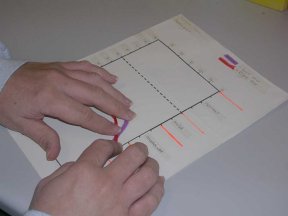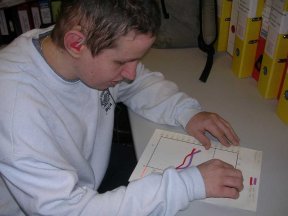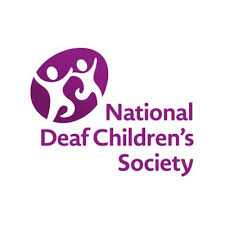A tactile audiogram for deafblind pupils
Marion Brushett, Wandsworth Hearing-Impaired Service
Linden Lodge is a unique school in Wandsworth, South-West London. It is an inclusive special school for children with a visual impairment and for children who have additional special educational needs.
The school promotes a multi-agency approach and peripatetic teachers for Hearing-Impaired pupils are part of the team. Pupils have varying types and degrees of hearing loss and twelve pupils have a permanent dual sensory impairment.
The idea for a tactile audiogram developed from the increasing need for deafblind children to have access to information. Observing children in their lessons, I saw other tactile resources used, eg raised maps in history, showing the routes of armies across Europe and graphs in maths. This impressed me. I was already using a smiley face reward sheet for hearing aid battery checks and hearing aid care using `Wikki Stix’ and I saw the potential of `swell paper’.
At Annual Reviews, in my role as the peripatetic ToD, I explain to families and other professionals the `shape’ of the pupils’ audiograms; what can and cannot be heard. In mainstream schools, children discuss their audiograms so they become familiar with audiological terms. How could children at Linden Lodge School become equally independent? We look at the model of the ear but the audiogram presents a problem.
The Learning Resource Department at Linden Lodge prepares resources to support teaching and learning and I discussed the idea of developing a tactile audiogram with Jane Overton, Teaching Assistant. Jane has a special interest in deafblind children, (she has the CACDP Deafblind Communicator Guide, Makaton, Braille and Moon qualifications and BSL Stage 2). Jane wanted to make the audiograms in Braille or Moon as simple as possible, yet containing all the auditory information. We discussed each child’s needs and level of understanding and Jane familiarised herself with each child’s audiogram.

The process used to produce a tactile audiogram takes several stages:
- On A4 paper, the audiogram outline frame is drawn and photocopied onto `Swell’ paper. (Paper that raises the outline/shape under heat.)
- This paper is put through a heat fusing machine which raises the outline to make the image tactile.
- Jane writes in print for the sighted people working with the children and puts Braille or Moon over this for the children to read.
- Along the top horizontal axis are the approximate phonic sounds: ‘a, e, b, ch, th,s’ which replace the usual frequencies.
- Down the left side are the decibels, 0 to 120 (-10 and -20 are complications at this stage). Decibels are described as levels of loudness.
- A dotted line across at 20dB marks the normal threshold of hearing.
- Down the right side are the descriptors of hearing levels: normal, mild, moderate, severe, profound.
- The amount and type of information given varies with each child’s needs.
- A key indicates the left and right ear thresholds, using different textures: felt for the left, raffia for the right.
- The materials are plotted according to the individual child’s hearing levels.

“My hearing is in the ‘moderate’ section, 50 to 70 and some in the ‘severe’ section, 70 to 90. One hundred and twenty dB is called ‘profound’ and people with this hearing loss may use sign language.” Once he leaves Linden Lodge School, Nathan can use the audiogram to explain to other people at college, work experience, or family and friends, about his level of hearing.
It may be that another teacher has already prepared a similar audiogram. I would like to share my experience because I have found the tactile audiogram has fulfilled its purpose, which is for able deafblind children to have greater understanding of their hearing loss. If you have children who may benefit from access to audiological information, talk to teachers in your local Visual Impairment service for help with the special techniques in the production of the audiogram. My thanks to Linden Lodge School staff and children.
March 2005



